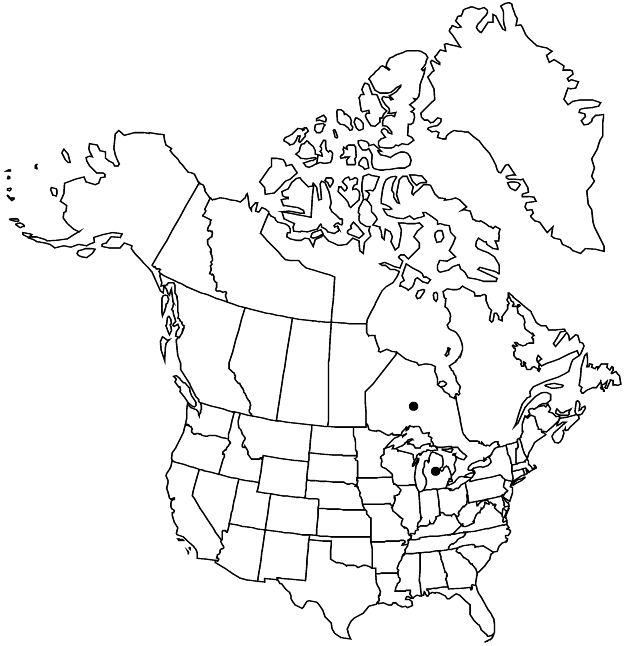familyRosaceae
subfamilyRosaceae subfam. Amygdaloideae
genusCrataegus
sectionCrataegus sect. Macracanthae
speciesCrataegus succulenta
Difference between revisions of "Crataegus succulenta var. michiganensis"
Brittonia 5: 489. 1946.
Endemic
Basionym: Crataegus michiganensis Ashe Bull. North Carolina Agric. Exp. Sta. 175: 111. 1900
Treatment appears in FNA Volume 9. Treatment on page 519.
FNA>Volume Importer |
imported>Volume Importer |
||
| (6 intermediate revisions by 2 users not shown) | |||
| Line 11: | Line 11: | ||
|label=Endemic | |label=Endemic | ||
}} | }} | ||
| − | |basionyms={{Treatment/ID/ | + | |basionyms={{Treatment/ID/Basionym |
|name=Crataegus michiganensis | |name=Crataegus michiganensis | ||
|authority=Ashe | |authority=Ashe | ||
| + | |rank=species | ||
| + | |publication_title=Bull. North Carolina Agric. Exp. Sta. | ||
| + | |publication_place=175: 111. 1900 | ||
}} | }} | ||
|synonyms= | |synonyms= | ||
| Line 30: | Line 33: | ||
|elevation=200–300 m | |elevation=200–300 m | ||
|distribution=Ont.;Mich. | |distribution=Ont.;Mich. | ||
| − | |discussion=<p>Variety michiganensis resembles var. succulenta but has white anthers. The similar but glabrate Crataegus tanuphylla Sargent was rediscovered in the 1990s in central Pennsylvania. Crataegus laxiflora Sargent [C. succulenta var. laxiflora (Sargent) Kruschke is similar to var. michiganensis] but has unusually lax inflorescences.</p> | + | |discussion=<p>Variety michiganensis resembles <i></i>var.<i> succulenta</i> but has white anthers. The similar but glabrate <i>Crataegus</i> tanuphylla Sargent was rediscovered in the 1990s in central Pennsylvania. <i>Crataegus</i> laxiflora Sargent [<i>C. succulenta</i> var. laxiflora (Sargent) Kruschke is similar to <i></i>var.<i> michiganensis</i>] but has unusually lax inflorescences.</p> |
|tables= | |tables= | ||
|references= | |references= | ||
| Line 39: | Line 42: | ||
-->{{#Taxon: | -->{{#Taxon: | ||
name=Crataegus succulenta var. michiganensis | name=Crataegus succulenta var. michiganensis | ||
| − | |||
|authority=(Ashe) E. J. Palmer | |authority=(Ashe) E. J. Palmer | ||
|rank=variety | |rank=variety | ||
| Line 54: | Line 56: | ||
|publication year=1946 | |publication year=1946 | ||
|special status=Endemic | |special status=Endemic | ||
| − | |source xml=https:// | + | |source xml=https://bitbucket.org/aafc-mbb/fna-data-curation/src/2e0870ddd59836b60bcf96646a41e87ea5a5943a/coarse_grained_fna_xml/V9/V9_875.xml |
|subfamily=Rosaceae subfam. Amygdaloideae | |subfamily=Rosaceae subfam. Amygdaloideae | ||
|tribe=Rosaceae tribe Gillenieae | |tribe=Rosaceae tribe Gillenieae | ||
Latest revision as of 23:00, 5 November 2020
Leaves: blade ovate to broadly elliptic, proportionately wide (1.3–1.6:1). Inflorescence branches pubescent. Anthers white. Pomes 7–10 mm diam.
Phenology: Flowering May; fruiting Sep–Oct.
Habitat: Brush, field margins, open woodlands
Elevation: 200–300 m
Discussion
Variety michiganensis resembles var. succulenta but has white anthers. The similar but glabrate Crataegus tanuphylla Sargent was rediscovered in the 1990s in central Pennsylvania. Crataegus laxiflora Sargent [C. succulenta var. laxiflora (Sargent) Kruschke is similar to var. michiganensis] but has unusually lax inflorescences.
Selected References
None.
Lower Taxa
None.
